1000 HP system fitted next Monday...
#152

Good question, I once did some runs with 250 hp of Nitrous and worked out my consumption at around 4 to 5 to the gallon...lol
With 1000 hp...as a guess......around 1 to 2 to the gallon.....
Just out of interest A Top Fuel car will use around 7 to 9 gallons for ONE QUARTER OF A MILE...

Thats Nitromethane and Methanol mixed though, not petrol.
All the best Brett

#153
Just for fun, I got this off of one of our discussion threads...since we're talking about Top Fuel:
"DEFINITION OF ACCELERATION" ... Fun Stuff !
(courtesy of KB Performance Pistons)
One top fuel dragster 500 cubic inch Hemi engine makes more horsepower than the first 4 rows of stock cars at the Daytona 500.
It takes just 15/100ths of a second for all 6,000+ horsepower of an NHRA Top Fuel dragster engine to reach the rear wheels.
Under full throttle, a dragster engine consumes 1-1/2 gallons of nitro methane per second; a fully loaded 747 consumes jet fuel at the same rate with 25% less energy being produced.
A stock Dodge Hemi V8 engine cannot produce enough power to drive the dragster's supercharger.
With 3,000 CFM of air being rammed in by the supercharger on overdrive, the fuel mixture is compressed into a near-solid form before ignition.
Cylinders run on the verge of hydraulic lock at full throttle.
At the stoichiometric (stoichiometry: methodology and technology by which quantities of reactants and products in chemical reactions are determined) 1.7:1 air/fuel mixture of nitro methane, the flame front temperature measures 7,050 deg F.
Nitro methane burns yellow. The spectacular white flame seen above the stacks at night is raw burning hydrogen, dissociated from atmospheric water vapor by the searing exhaust gases.
Dual magnetos supply 44 amps to each spark plug. This is the output of an arc welder in each cylinder.
Spark plug electrodes are totally consumed during a pass. After halfway, the engine is dieseling from compression, plus the glow of exhaust valves at 1,400 deg F. The engine can only be shut down by cutting the fuel flow.
If spark momentarily fails early in the run, unburned nitro builds up in the affected cylinders and then explodes with sufficient force to blow cylinder heads off the block in pieces or split the block in half.
In order to exceed 300 mph in 4.5 seconds, dragsters must accelerate an average of over 4G's. In order to reach 200 mph (well before half-track), the launch acceleration approaches 8G's.
Dragsters reach over 300 miles per hour before you have completed reading this sentence.
Top fuel engines turn approximately 540 revolutions from light to light! Including the burnout, the engine must only survive 900 revolutions under load.
The redline is actually quite high at 9,500 rpm.
Assuming all the equipment is paid off, the crew worked for free, and for once NOTHING BLOWS UP, each run costs an estimate $1,000.00 per second.
The current top fuel dragster elapsed time record is 4.428 seconds for the quarter mile (11/12/06, Tony Schumacher, at Pomona, CA). The top speed record is 336.15 mph as measured over the last 66' of the run (05/25/05 Tony Schumacher, at Hebron, OH).
Putting all of this into perspective:
You are driving the average $140,000 Lingenfelter "twin-turbo" powered Corvette Z06. Over a mile up the road, a top fuel dragster is staged and ready to launch down a quarter mile strip as you pass. You have the advantage of a flying start. You run the 'Vette hard up through the gears and blast across the starting line and pass the dragster at an honest 200 mph. The "tree" goes green for both of you at that moment.
The dragster launches and starts after you. You keep your foot down hard, but you hear an incredibly brutal whine that sears your eardrums and within 3 seconds, the dragster catches and passes yo u. He beats you to the finish line, a quarter mile away from where you just passed him.
Think about it, from a standing start, the dragster had spotted you 200 mph and not only caught, but nearly blasted you off the road when he passed you within a mere 1,320 foot long race course.
... and that my friend, is ACCELERATION!
"DEFINITION OF ACCELERATION" ... Fun Stuff !
(courtesy of KB Performance Pistons)
One top fuel dragster 500 cubic inch Hemi engine makes more horsepower than the first 4 rows of stock cars at the Daytona 500.
It takes just 15/100ths of a second for all 6,000+ horsepower of an NHRA Top Fuel dragster engine to reach the rear wheels.
Under full throttle, a dragster engine consumes 1-1/2 gallons of nitro methane per second; a fully loaded 747 consumes jet fuel at the same rate with 25% less energy being produced.
A stock Dodge Hemi V8 engine cannot produce enough power to drive the dragster's supercharger.
With 3,000 CFM of air being rammed in by the supercharger on overdrive, the fuel mixture is compressed into a near-solid form before ignition.
Cylinders run on the verge of hydraulic lock at full throttle.
At the stoichiometric (stoichiometry: methodology and technology by which quantities of reactants and products in chemical reactions are determined) 1.7:1 air/fuel mixture of nitro methane, the flame front temperature measures 7,050 deg F.
Nitro methane burns yellow. The spectacular white flame seen above the stacks at night is raw burning hydrogen, dissociated from atmospheric water vapor by the searing exhaust gases.
Dual magnetos supply 44 amps to each spark plug. This is the output of an arc welder in each cylinder.
Spark plug electrodes are totally consumed during a pass. After halfway, the engine is dieseling from compression, plus the glow of exhaust valves at 1,400 deg F. The engine can only be shut down by cutting the fuel flow.
If spark momentarily fails early in the run, unburned nitro builds up in the affected cylinders and then explodes with sufficient force to blow cylinder heads off the block in pieces or split the block in half.
In order to exceed 300 mph in 4.5 seconds, dragsters must accelerate an average of over 4G's. In order to reach 200 mph (well before half-track), the launch acceleration approaches 8G's.
Dragsters reach over 300 miles per hour before you have completed reading this sentence.
Top fuel engines turn approximately 540 revolutions from light to light! Including the burnout, the engine must only survive 900 revolutions under load.
The redline is actually quite high at 9,500 rpm.
Assuming all the equipment is paid off, the crew worked for free, and for once NOTHING BLOWS UP, each run costs an estimate $1,000.00 per second.
The current top fuel dragster elapsed time record is 4.428 seconds for the quarter mile (11/12/06, Tony Schumacher, at Pomona, CA). The top speed record is 336.15 mph as measured over the last 66' of the run (05/25/05 Tony Schumacher, at Hebron, OH).
Putting all of this into perspective:
You are driving the average $140,000 Lingenfelter "twin-turbo" powered Corvette Z06. Over a mile up the road, a top fuel dragster is staged and ready to launch down a quarter mile strip as you pass. You have the advantage of a flying start. You run the 'Vette hard up through the gears and blast across the starting line and pass the dragster at an honest 200 mph. The "tree" goes green for both of you at that moment.
The dragster launches and starts after you. You keep your foot down hard, but you hear an incredibly brutal whine that sears your eardrums and within 3 seconds, the dragster catches and passes yo u. He beats you to the finish line, a quarter mile away from where you just passed him.
Think about it, from a standing start, the dragster had spotted you 200 mph and not only caught, but nearly blasted you off the road when he passed you within a mere 1,320 foot long race course.
... and that my friend, is ACCELERATION!
#154
Incredible. I was also reading Autoweek the other day and it listed that a Top Fuel dragster accellerates from 0-100 mph in 0.8 seconds. I can not imagine how brutal the accelleration must be. And to think I was impressed by how my stock 928 accelerates.
#155
They are quick, and loud.
Most of the long time drivers suffer from back problems and hemrroids from the G-forces.
Bristol night session last year
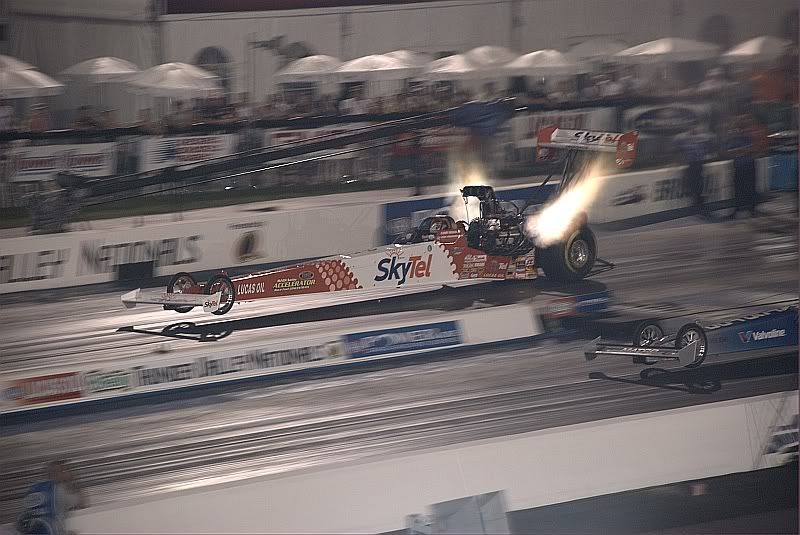
Jim Head under power at Atlanta last year.
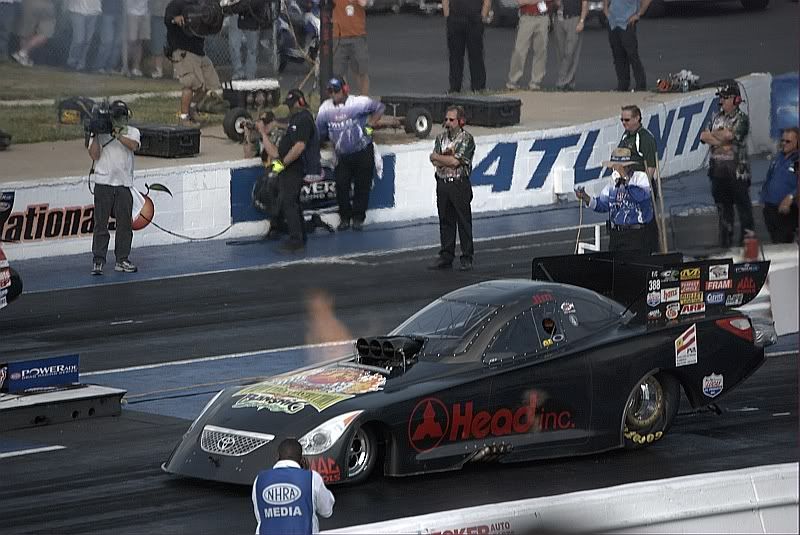
The Man at Atlanta.
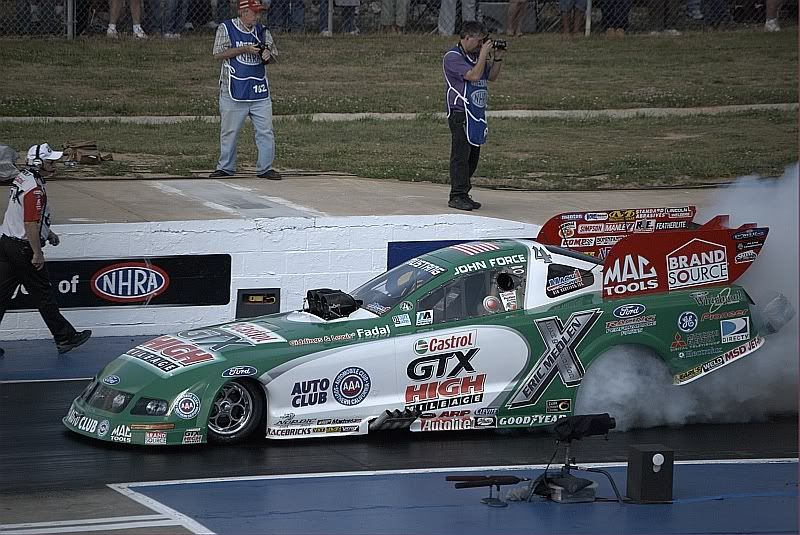
John and Robert talking about the new safety stuff after Erics Medlins death last year.
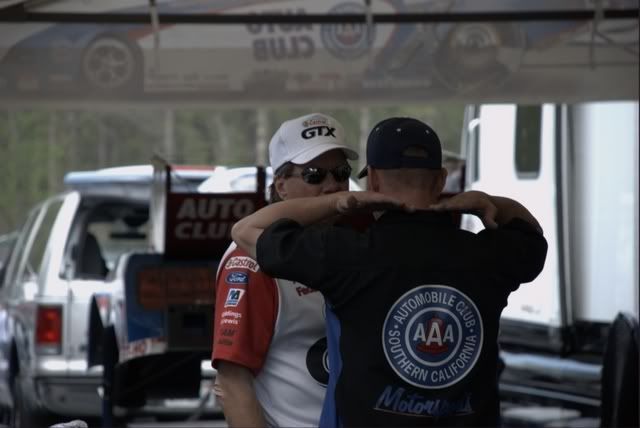
They are running up to 90% this year, up from 85% last year.
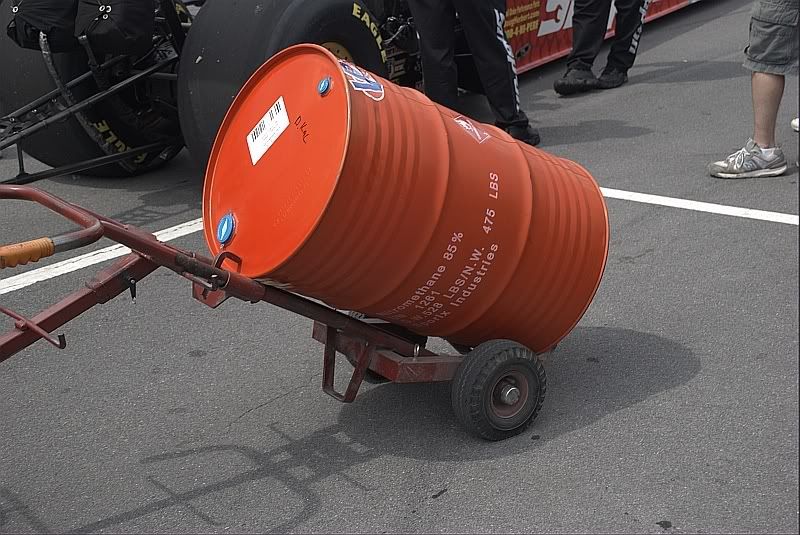
Kenny Bernstien at Memphis last year.
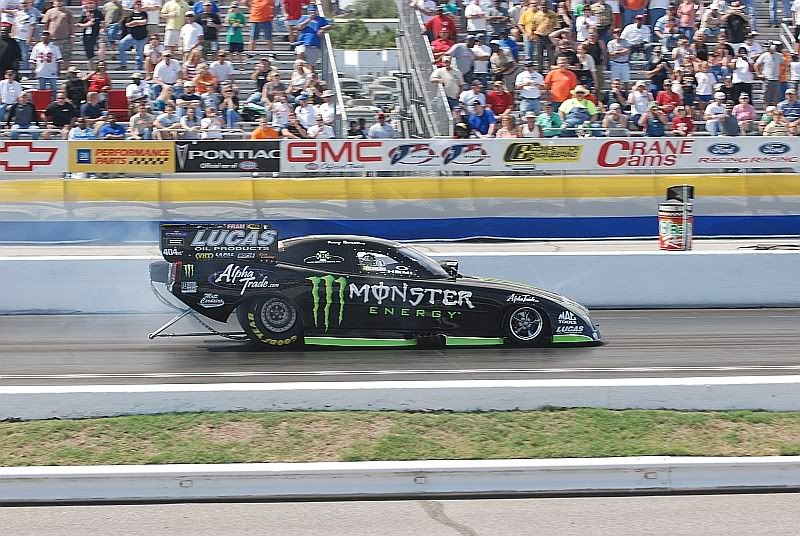
Gasoline is for washing parts, Alcohol is for drinking, nitromethane is for racing. Don Garltlis
Greg
Most of the long time drivers suffer from back problems and hemrroids from the G-forces.
Bristol night session last year

Jim Head under power at Atlanta last year.

The Man at Atlanta.

John and Robert talking about the new safety stuff after Erics Medlins death last year.

They are running up to 90% this year, up from 85% last year.

Kenny Bernstien at Memphis last year.

Gasoline is for washing parts, Alcohol is for drinking, nitromethane is for racing. Don Garltlis
Greg

#157
Owns the Streets
Needs Camber
Lifetime Rennlist
Member
Needs Camber
Lifetime Rennlist
Member
Joined: May 2003
Posts: 10,292
Likes: 1
From: New York
Just making sure the fuel cell/tank doesn't run dry and the mixture goes waaaay lean.
80 litres isn't a lot when you're very very thirsty.
80 litres isn't a lot when you're very very thirsty.
Hi 
Good question, I once did some runs with 250 hp of Nitrous and worked out my consumption at around 4 to 5 to the gallon...lol
With 1000 hp...as a guess......around 1 to 2 to the gallon.....
Just out of interest A Top Fuel car will use around 7 to 9 gallons for ONE QUARTER OF A MILE...
Thats Nitromethane and Methanol mixed though, not petrol.
All the best Brett

Good question, I once did some runs with 250 hp of Nitrous and worked out my consumption at around 4 to 5 to the gallon...lol
With 1000 hp...as a guess......around 1 to 2 to the gallon.....
Just out of interest A Top Fuel car will use around 7 to 9 gallons for ONE QUARTER OF A MILE...

Thats Nitromethane and Methanol mixed though, not petrol.
All the best Brett

#158
#160
Why not just compare that Lingenfelter Corvette to the freaking space shuttle or a damn tomahawk missle for what thats worth. You ain't driving a dragster on the street, so therefor in my book the sport is stupid. The real thrill is streetable AUTOMOBILES running 1/4's.
#161
Thats all at STP.
so, the difference is that NOS is in liquid form in the bottle, so when it is released in a fog (or vapor) it is MUCH more dense as well. So, your comparison below is pretty accurate, but it leaves out the major advantage of the density difference of NOS as it hits STP out of a bottle. At the vapor stage, the temp is still very low, but the density is near 3x more, as compared to NOS as a gas at STP.
mk
so, the difference is that NOS is in liquid form in the bottle, so when it is released in a fog (or vapor) it is MUCH more dense as well. So, your comparison below is pretty accurate, but it leaves out the major advantage of the density difference of NOS as it hits STP out of a bottle. At the vapor stage, the temp is still very low, but the density is near 3x more, as compared to NOS as a gas at STP.
mk
Simple facts,
There are about 0.045 mols of oxygen per liter of nitrous oxide at STP
There are about 0.0075 mols of O2 per liter of air at STP
Thus, per volume, Nitrous Oxide gas contains about 3 times more atoms of oxygen at STP
Thus, in theory he can burn as much as 3 times more fuel if he ran entirely nitrous oxide.
Thus, his engine can in theory injest a "1000" shot of nitrous.
Who knows what it will do with it once injested though...
I'm tired and I did that math in my head so I probably made mistakes, but feel free to check my work.
There are about 0.045 mols of oxygen per liter of nitrous oxide at STP
There are about 0.0075 mols of O2 per liter of air at STP
Thus, per volume, Nitrous Oxide gas contains about 3 times more atoms of oxygen at STP
Thus, in theory he can burn as much as 3 times more fuel if he ran entirely nitrous oxide.
Thus, his engine can in theory injest a "1000" shot of nitrous.
Who knows what it will do with it once injested though...
I'm tired and I did that math in my head so I probably made mistakes, but feel free to check my work.
#162
Chronic Tool Dropper
Lifetime Rennlist
Member
Lifetime Rennlist
Member
Joined: Oct 2001
Posts: 20,506
Likes: 549
From: Bend, Oregon
Mark--
A reminder that the cooling you experience is from the heat of evaporation, BTU's borrowed from the intake air charge and ultimately the surrounding metal. The sensible heat change is easy to calculate too, but changes as bottle temp drops.
... Did I say the bottle temp drops??? That means the stuff is changing state somewhere other than downstream of the nozzle, right? I had a peeky at a really pretty NOS setup last weekend. I just couldn't figure out why the install includes 1/4" OD metal lines from the bottles, going to 1/4" ID flex lines to the nozzles. And a claim of 500 HP added. It will be togh to get that much mass through those little pipes as liquid, and impossible if you are flashing to vapor upstream of the nozzles in that flex area.
Simple test-- Where does the system get cold? That's prtetty much where your state change (and max available cooling effect) will be happening. Spraying liquid into the intake will cool it --if the liquid is allowed to flash to vapor there--. That means the pressure has to drop, something you expect --because the throttle is open to atmosphere at one end of the intake pipes and the engine is sucking VAPOR in at the other end. Video show cold fog from the throttle, right? The liquid is now vapor at atmospheric pressure. At this point the DENSITY of the gas follows perfect gas law, right? Cold vapor at atmosphereic pressure. Is any liquid NOS neing drawn into the cylinders to be compressed into gas as the cylinder comes up again? It's a snow snake, Mark, your own, and it's pulling on your own leg!
Brett, I wish you all the best my friend! Maybe the 1000 degree valves will transfer enough heat to the liquid NOS that makes it to the cylinders to flash to vapor before the pistons start upwards. Maybe the fuel charge will warm up enough at that point to flash to vapor too, and maybe the plugs will ignite the mixture at the right moment. I'm no expert on NOS, obviously. I do remember a little of the physics. Not enough to argue with Mark, but generally enough to be able to teach it. To get near your stated HP goals, you'll be riding just south of supercritical in the intake charge, and that's a delicate spot beyond which there is no forgiveness. Again, good luck, be safe, and take lots of video please.
A reminder that the cooling you experience is from the heat of evaporation, BTU's borrowed from the intake air charge and ultimately the surrounding metal. The sensible heat change is easy to calculate too, but changes as bottle temp drops.
... Did I say the bottle temp drops??? That means the stuff is changing state somewhere other than downstream of the nozzle, right? I had a peeky at a really pretty NOS setup last weekend. I just couldn't figure out why the install includes 1/4" OD metal lines from the bottles, going to 1/4" ID flex lines to the nozzles. And a claim of 500 HP added. It will be togh to get that much mass through those little pipes as liquid, and impossible if you are flashing to vapor upstream of the nozzles in that flex area.
Simple test-- Where does the system get cold? That's prtetty much where your state change (and max available cooling effect) will be happening. Spraying liquid into the intake will cool it --if the liquid is allowed to flash to vapor there--. That means the pressure has to drop, something you expect --because the throttle is open to atmosphere at one end of the intake pipes and the engine is sucking VAPOR in at the other end. Video show cold fog from the throttle, right? The liquid is now vapor at atmospheric pressure. At this point the DENSITY of the gas follows perfect gas law, right? Cold vapor at atmosphereic pressure. Is any liquid NOS neing drawn into the cylinders to be compressed into gas as the cylinder comes up again? It's a snow snake, Mark, your own, and it's pulling on your own leg!
Brett, I wish you all the best my friend! Maybe the 1000 degree valves will transfer enough heat to the liquid NOS that makes it to the cylinders to flash to vapor before the pistons start upwards. Maybe the fuel charge will warm up enough at that point to flash to vapor too, and maybe the plugs will ignite the mixture at the right moment. I'm no expert on NOS, obviously. I do remember a little of the physics. Not enough to argue with Mark, but generally enough to be able to teach it. To get near your stated HP goals, you'll be riding just south of supercritical in the intake charge, and that's a delicate spot beyond which there is no forgiveness. Again, good luck, be safe, and take lots of video please.
#163
keep in mind, the lines and even the bottle has different levels of changing states. thus the reason for the bottle heater. where the vapor finally is a gas, is probably moments after its injected into the cylinders. hey, its expansion probably applies some pressure on the pistons way down 
however, as a vapor, it can be 3x more dense than just NOS as a gas at STP.
this is becuase out of the nossil, it starts to heat and the pressure instantly rises, as fast as the tempurature drops. NOS will exit the line and have varing degrees of state change based on tempuratures. Like a flame, the center of the spray might be near critical tempurature,while the outer flame areas might be in a gass state. as you know, if i spayed NOS on something even a foot away, i can get it to freeze. This alone proves that the temperature of the NOS spray is very low temp, as expected and by being so, would be in the vapor state, or near critical temp, where it is 3x the density. and that is the point.
as far as the "little tiny lines" supporting real hp, keep in mind, i had no problem at all putting the mass flow of 75hp through one nossle like the one pictured on this thread. Brett is planning on using 8 of these, one on each cylinder. I guess in theory, just the moderate quantity and volume of NOS i used to produce 75 hp, could be thought to be fed to each cylinder. thats near 600hp alone. so, i dont think the line size and the mass flow to create 1000+ hp is an issue if NOS is injected in this way.
mk

however, as a vapor, it can be 3x more dense than just NOS as a gas at STP.
this is becuase out of the nossil, it starts to heat and the pressure instantly rises, as fast as the tempurature drops. NOS will exit the line and have varing degrees of state change based on tempuratures. Like a flame, the center of the spray might be near critical tempurature,while the outer flame areas might be in a gass state. as you know, if i spayed NOS on something even a foot away, i can get it to freeze. This alone proves that the temperature of the NOS spray is very low temp, as expected and by being so, would be in the vapor state, or near critical temp, where it is 3x the density. and that is the point.
as far as the "little tiny lines" supporting real hp, keep in mind, i had no problem at all putting the mass flow of 75hp through one nossle like the one pictured on this thread. Brett is planning on using 8 of these, one on each cylinder. I guess in theory, just the moderate quantity and volume of NOS i used to produce 75 hp, could be thought to be fed to each cylinder. thats near 600hp alone. so, i dont think the line size and the mass flow to create 1000+ hp is an issue if NOS is injected in this way.
mk
Mark--
A reminder that the cooling you experience is from the heat of evaporation, BTU's borrowed from the intake air charge and ultimately the surrounding metal. The sensible heat change is easy to calculate too, but changes as bottle temp drops.
... Did I say the bottle temp drops??? That means the stuff is changing state somewhere other than downstream of the nozzle, right? I had a peeky at a really pretty NOS setup last weekend. I just couldn't figure out why the install includes 1/4" OD metal lines from the bottles, going to 1/4" ID flex lines to the nozzles. And a claim of 500 HP added. It will be togh to get that much mass through those little pipes as liquid, and impossible if you are flashing to vapor upstream of the nozzles in that flex area.
Simple test-- Where does the system get cold? That's prtetty much where your state change (and max available cooling effect) will be happening. Spraying liquid into the intake will cool it --if the liquid is allowed to flash to vapor there--. That means the pressure has to drop, something you expect --because the throttle is open to atmosphere at one end of the intake pipes and the engine is sucking VAPOR in at the other end. Video show cold fog from the throttle, right? The liquid is now vapor at atmospheric pressure. At this point the DENSITY of the gas follows perfect gas law, right? Cold vapor at atmosphereic pressure. Is any liquid NOS neing drawn into the cylinders to be compressed into gas as the cylinder comes up again? It's a snow snake, Mark, your own, and it's pulling on your own leg!
Brett, I wish you all the best my friend! Maybe the 1000 degree valves will transfer enough heat to the liquid NOS that makes it to the cylinders to flash to vapor before the pistons start upwards. Maybe the fuel charge will warm up enough at that point to flash to vapor too, and maybe the plugs will ignite the mixture at the right moment. I'm no expert on NOS, obviously. I do remember a little of the physics. Not enough to argue with Mark, but generally enough to be able to teach it. To get near your stated HP goals, you'll be riding just south of supercritical in the intake charge, and that's a delicate spot beyond which there is no forgiveness. Again, good luck, be safe, and take lots of video please.
A reminder that the cooling you experience is from the heat of evaporation, BTU's borrowed from the intake air charge and ultimately the surrounding metal. The sensible heat change is easy to calculate too, but changes as bottle temp drops.
... Did I say the bottle temp drops??? That means the stuff is changing state somewhere other than downstream of the nozzle, right? I had a peeky at a really pretty NOS setup last weekend. I just couldn't figure out why the install includes 1/4" OD metal lines from the bottles, going to 1/4" ID flex lines to the nozzles. And a claim of 500 HP added. It will be togh to get that much mass through those little pipes as liquid, and impossible if you are flashing to vapor upstream of the nozzles in that flex area.
Simple test-- Where does the system get cold? That's prtetty much where your state change (and max available cooling effect) will be happening. Spraying liquid into the intake will cool it --if the liquid is allowed to flash to vapor there--. That means the pressure has to drop, something you expect --because the throttle is open to atmosphere at one end of the intake pipes and the engine is sucking VAPOR in at the other end. Video show cold fog from the throttle, right? The liquid is now vapor at atmospheric pressure. At this point the DENSITY of the gas follows perfect gas law, right? Cold vapor at atmosphereic pressure. Is any liquid NOS neing drawn into the cylinders to be compressed into gas as the cylinder comes up again? It's a snow snake, Mark, your own, and it's pulling on your own leg!
Brett, I wish you all the best my friend! Maybe the 1000 degree valves will transfer enough heat to the liquid NOS that makes it to the cylinders to flash to vapor before the pistons start upwards. Maybe the fuel charge will warm up enough at that point to flash to vapor too, and maybe the plugs will ignite the mixture at the right moment. I'm no expert on NOS, obviously. I do remember a little of the physics. Not enough to argue with Mark, but generally enough to be able to teach it. To get near your stated HP goals, you'll be riding just south of supercritical in the intake charge, and that's a delicate spot beyond which there is no forgiveness. Again, good luck, be safe, and take lots of video please.
#164
The current top fuel dragster elapsed time record is 4.428 seconds for the quarter mile (11/12/06, Tony Schumacher, at Pomona, CA)....The dragster launches and starts after you. You keep your foot down hard, but you hear an incredibly brutal whine that sears your eardrums and within 3 seconds, the dragster catches and passes yo u. He beats you to the finish line, a quarter mile away from where you just passed him.
Think about it, from a standing start, the dragster had spotted you 200 mph and not only caught, but nearly blasted you off the road when he passed you within a mere 1,320 foot long race course.
Think about it, from a standing start, the dragster had spotted you 200 mph and not only caught, but nearly blasted you off the road when he passed you within a mere 1,320 foot long race course.
200mph = 293.333 ft/sec
1320 ft @ 293.333 ft/sec will take you 4.5 seconds, so the very fastest top fueler may nip you at the line, but won't catch you in 3 seconds.
Sorry, but occasionally the engineer in me comes out.
#165
Cool article with lots of interesting facts, but I think the some of the math is wrong:
200mph = 293.333 ft/sec
1320 ft @ 293.333 ft/sec will take you 4.5 seconds, so the very fastest top fueler may nip you at the line, but won't catch you in 3 seconds.
Sorry, but occasionally the engineer in me comes out.
200mph = 293.333 ft/sec
1320 ft @ 293.333 ft/sec will take you 4.5 seconds, so the very fastest top fueler may nip you at the line, but won't catch you in 3 seconds.
Sorry, but occasionally the engineer in me comes out.
The top fuel car is at 100 in less than .8 seconds and well past 200 in 2 seconds.
Over 280 at the 660 FT mark.
I guess what I am trying to say is the acceleration is not constant.
Greg

EDIT:Anton Browns incrementals from Pomana two weeks ago.
Antron Brown's incremental times: 60ft-0.862 sec., 330ft-2.152, 660ft-3.059/278.40mph, 1,000ft-3.824
Not a record, but still stout.
Last edited by blown 87; 02-22-2008 at 11:52 PM.


